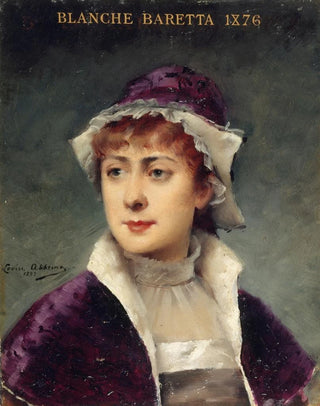Art print | Portrait of Blanche Baretta 1855-1939 Member of the Comédie-Française - Louise Abbéma


View from behind

Frame (optional)
Portrait Art print of Blanche Baretta 1855-1939 Sociétaire De La Comédie-Française by Louise Abbéma – Engaging introduction
In the vast panorama of art history, certain works stand out for their ability to capture not only the appearance of a subject but also its very essence. The "Portrait Art print of Blanche Baretta 1855-1939 Sociétaire De La Comédie-Française" by Louise Abbéma is a perfect example. This painting, created in the early 20th century, transcends a simple portrait to offer a glimpse into the theatrical world of its time. Blanche Baretta, an iconic figure of the Comédie-Française, is depicted with such finesse that one can almost hear the echoes of her performances. Through this painting, Abbéma invites us to explore the beauty and complexity of French theater, while paying tribute to a woman who marked her era.
Style and uniqueness of the work
Louise Abbéma's style is characterized by delicacy and precision that bring her portraits to life. In the case of Blanche Baretta, the artist manages to combine refined technique with palpable emotion. The chosen colors, soft and nuanced, evoke an intimate atmosphere, while Baretta's gaze, both captivating and contemplative, draws the observer into a silent dialogue. The composition is carefully balanced, with each element of the painting serving to reinforce the presence of the protagonist. The details of clothing and accessories, meticulously crafted, testify to a meticulous attention to textures and reflections, characteristic of Abbéma's style. This portrait is not just a representation; it is an invitation to discover the universe of French stage, where every gesture and every look are charged with meaning.
The artist and her influence
Louise Abbéma, a French-born artist, made a name for herself in a male-dominated field. Born in 1853, she was one of the first women recognized for her talent in the field of painting. Her career was marked by encounters with iconic figures of her time, such as Sarah Bernhardt, who was also one of her subjects. Abbéma captured the spirit of her era, blending realism with a touch of romanticism. Her work influenced many artists

Matte finish

View from behind

Frame (optional)
Portrait Art print of Blanche Baretta 1855-1939 Sociétaire De La Comédie-Française by Louise Abbéma – Engaging introduction
In the vast panorama of art history, certain works stand out for their ability to capture not only the appearance of a subject but also its very essence. The "Portrait Art print of Blanche Baretta 1855-1939 Sociétaire De La Comédie-Française" by Louise Abbéma is a perfect example. This painting, created in the early 20th century, transcends a simple portrait to offer a glimpse into the theatrical world of its time. Blanche Baretta, an iconic figure of the Comédie-Française, is depicted with such finesse that one can almost hear the echoes of her performances. Through this painting, Abbéma invites us to explore the beauty and complexity of French theater, while paying tribute to a woman who marked her era.
Style and uniqueness of the work
Louise Abbéma's style is characterized by delicacy and precision that bring her portraits to life. In the case of Blanche Baretta, the artist manages to combine refined technique with palpable emotion. The chosen colors, soft and nuanced, evoke an intimate atmosphere, while Baretta's gaze, both captivating and contemplative, draws the observer into a silent dialogue. The composition is carefully balanced, with each element of the painting serving to reinforce the presence of the protagonist. The details of clothing and accessories, meticulously crafted, testify to a meticulous attention to textures and reflections, characteristic of Abbéma's style. This portrait is not just a representation; it is an invitation to discover the universe of French stage, where every gesture and every look are charged with meaning.
The artist and her influence
Louise Abbéma, a French-born artist, made a name for herself in a male-dominated field. Born in 1853, she was one of the first women recognized for her talent in the field of painting. Her career was marked by encounters with iconic figures of her time, such as Sarah Bernhardt, who was also one of her subjects. Abbéma captured the spirit of her era, blending realism with a touch of romanticism. Her work influenced many artists






